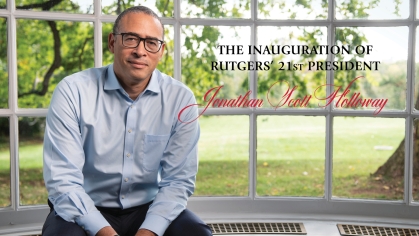Message from the Chancellor: Fall 2020 Academic Planning
Dear Rutgers University – Newark community members,
I write to follow up on President Barchi’s message. As we join our colleagues across Rutgers in preparing for a Fall 2020 semester calibrated to the still-evolving circumstances of the COVID-19 pandemic, I thought it would be useful to describe the ongoing academic planning at Rutgers-Newark.
Our highest priority remains the health and safety of our Rutgers-Newark family members. We are acutely aware that under normal circumstances we are an exceptionally mobile university community with an overwhelming majority of people who commute to and from our campus from widely varied locations; we know that our students, faculty, and staff will continue to face a wide range of personal and localized challenges for months to come. We also remain acutely attuned to the recommendations of federal, state, and local healthcare officials, and will adjust all of our plans in the coming months, as President Barchi noted, to follow social distancing and testing and tracing guidelines.
We have been working very closely in concert with the deans, and they with their faculties and staffs, to establish guiding principles for the roadmap ahead. Our instructional practices for the Fall semester must balance both our desire to teach and learn together and the reality of an extended recovery period in which we will only be able to gradually reinstate full in-person instruction.
We envision utilizing a 3-component model for courses that are usually held on campus: (1) instruction and materials delivered remotely for asynchronous learning, (2) synchronous remote interaction, and (3) in-person instruction where feasible. If we are not able to be fully in-person, we will prioritize in-person instruction first in courses in which use of the university’s physical infrastructure can most benefit instruction—such as the laboratory sciences and the arts—and in which it is feasible to adhere to the strict precautions of public health officials—such as in smaller classes most common in graduate programs; individualized and small-group activities; monitored lab work; and research work in archives, labs, studios, and seminars.
For the other courses, in the event that substantive components of the course must be delivered remotely, our faculty will make efforts to interact directly with the students. This may involve instruction and materials that are asynchronously delivered, with synchronous "live" (but still remote) sessions being held to enhance the learning experience. Additionally, it may be possible as public health guidance evolves for these live sessions to also be held in person by splitting up the class and utilizing classroom space to allow for social distancing, with students having the opportunity to attend a certain number of sessions in the semester. This in-class interaction could complement, not replace, the learning that takes place remotely (e.g., clarify difficult concepts, enable live demonstrations). Furthermore, for students who are not able to attend a class in person, due for example to health considerations, faculty would still provide opportunities for direct but remote synchronous interactions.
As we focus on planning for the possible need for continued remote instruction, we are fully cognizant of the digital divide. Throughout the spring, we have surveyed faculty, students, and staff to identify individuals who may not have the bandwidth or hardware to engage fully in remote teaching, learning, and support and have found solutions for them through expanded equipment loan programs, connection with service providers, and the dissemination of less technically demanding tools and practices. We will continue this work, but we also look forward to enabling faculty, students, and staff who may have less than ideal work environments at home, or for whom access to disability accommodations and services are important, to return to campus to access services and use offices, libraries, and computing labs once again. Our computer labs already have been configured to ensure adequate social distancing, and we intend to open our libraries in a safe manner taking all necessary precautions, once state guidance permits us to do so.
While this message has focused on academic planning, we know that many of you already are aware of the creative ways that our leaders in Enrollment and Student Experience and in Student Affairs have been working around the clock to deliver essential services remotely (e.g., financial aid advising, counseling, and telehealth) and host virtual events that are seeing substantial participation (e.g., Admitted Student Day, De-Stress Fest). In keeping with our goal to maintain the thriving community that is a hallmark of the Rutgers-Newark experience while also observing public health guidelines, Student Life and Residence Life are developing plans to work in hybrid formats that parallel our academic plans: some offices and programs will be available remotely, while many will have in-person options available for students.
The Rutgers-Newark community has exhibited amazing flexibility and resilience as well as an inspiring commitment to one another throughout our response thus far to the unprecedented environment created by the pandemic. We are profoundly grateful to all students, faculty, and staff who have contributed in any and every way to maintaining this spirit of togetherness—and to continuing it into our evolving plans for Fall 2020. As we proceed down this road together, we send fervent hopes for safety and health to you, your loved ones, and communities.
Cordially,
Nancy Cantor
Chancellor
Rutgers University – Newark


